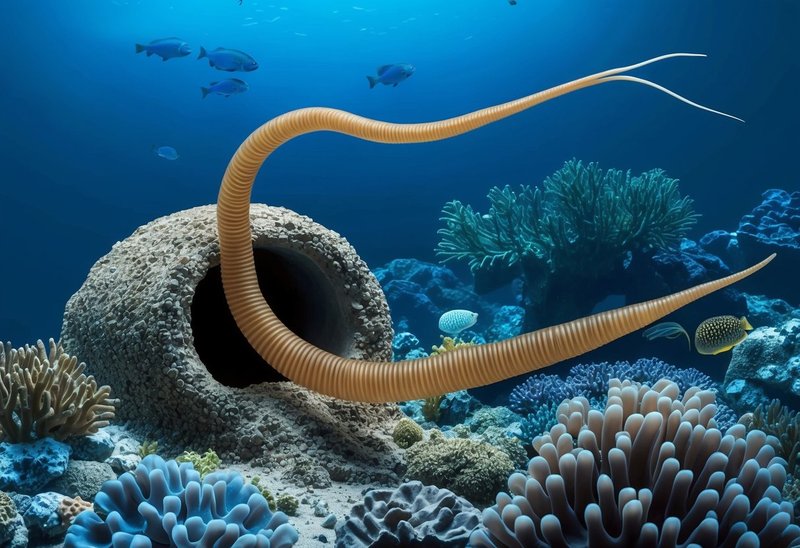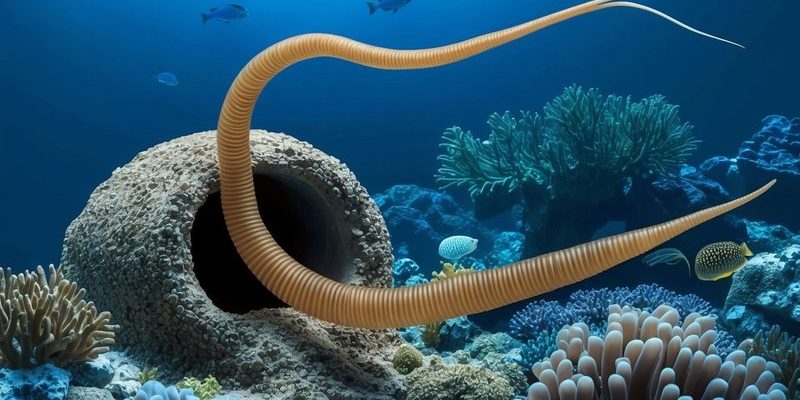
Now, when it comes to the colorful and competitive world of coral reefs, the question arises: do Bobbit worms compete with other reef predators? Let’s dive into the depths of their ocean home to see how these extraordinary worms fit into the food web and who their competitors might be.
Understanding Bobbit Worms
Bobbit worms, or *Eunice aphroditois*, can grow up to ten feet long! They live in burrows on the ocean floor, primarily in warm, tropical waters. Their long bodies are segmented with a vibrant mix of colors, often resembling a beautiful piece of art rather than a predator. When they’re not hiding, they extend their segments out of the burrow, appearing much like a plant.
You might be wondering how these creatures capture their prey. Bobbit worms have powerful jaws that snap shut quickly, allowing them to snatch fish, crustaceans, and even other worms. Their method of hunting is quite fascinating—suddenly shooting out of their burrow to catch dinner. This ambush strategy makes them effective predators, but it also means they face competition for food.
The Competitive Landscape of Coral Reefs
Coral reefs are teeming with life, which means countless predators are vying for the same food sources. Besides Bobbit worms, the reef is home to a diverse group of hunters, including lionfish, moray eels, and octopuses. Each of these creatures has its own unique hunting style, creating a dynamic food web.
Lionfish, for example, are known for their striking appearance and venomous spines. They’re formidable hunters, often preying on smaller fish, which puts them in direct competition with Bobbit worms. Moray eels, with their elongated bodies and sharp teeth, also hunt similar prey, adding to the competition. But the question remains—how do Bobbit worms hold their ground in this bustling ecosystem?
Bobbit Worms vs. Other Reef Predators
While Bobbit worms do face competition, they have some advantages that help them thrive. First off, their ambush strategy allows them to remain relatively hidden while waiting for the right moment to strike. This tactic can be more effective than the chasing methods used by many competitors.
Additionally, Bobbit worms have a unique ability to regenerate. If they lose a segment during a territorial dispute or another confrontation, they can grow it back. This resilience gives them an edge over other reef predators who may not have the same regenerative abilities. The combination of camouflage and regeneration makes Bobbit worms formidable competitors in the reef ecosystem.
Feeding Habits and Strategies
Bobbit worms are opportunistic feeders, meaning they don’t just rely on one type of prey. Their diet can include a variety of marine life, such as fish, crustaceans, and even other worms. This flexibility allows them to adapt to the availability of food in their environment.
When they sense movement near their burrow, they can strike with incredible speed. Their hunting skills are built on a keen sense of vibration, allowing them to detect potential meals nearby. Here’s the thing: while other predators might be more mobile, the Bobbit worm’s patience often pays off.
The Role of Bobbit Worms in the Reef Ecosystem
Bobbit worms play a crucial role in the coral reef ecosystem, not just as predators but also as part of the food chain. They help to control the populations of smaller fish and invertebrates, maintaining balance within the reef. By preying on these species, they prevent overpopulation, which can lead to a decline in reef health.
Furthermore, their burrowing activity helps aerate the substrate, promoting healthier conditions for other marine life. It’s fascinating how one creature, often overlooked, contributes to the overall health of its environment. This interplay is essential for the resilience of the reef ecosystem.
In summary, Bobbit worms are indeed competitors with other reef predators, but they’ve carved out their niche in a world bustling with life. Their unique hunting strategies, regenerative abilities, and flexible diets make them successful survivors. While they share their habitat with fearsome competitors like lionfish and moray eels, Bobbit worms hold their own in the complex web of ocean life.
So, next time you hear about Bobbit worms, remember they’re much more than just odd-looking creatures hiding in the sand. They’re fascinating predators with vital roles in their ecosystems, showcasing the intricate balance of life beneath the waves. Isn’t it amazing how something so seemingly simple can have such a big impact?

